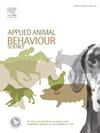The Jekyll and Hyde fish: Phenotype as a determinant of the invasion potential of Polypterus senegalus Cuvier, 1829
IF 2.2
2区 农林科学
Q1 AGRICULTURE, DAIRY & ANIMAL SCIENCE
引用次数: 0
Abstract
Biological invasions lead to considerable environmental and socioeconomic losses globally. For freshwater fish, the invasion potential of different phenotypes of the same species is influenced by various behavioural and physiological traits. In this study, we compared traits related to invasion potential between albino and pigmented grey bichir (Polypterus senegalus). This species, which is native to Africa, is widely traded as an ornamental animal worldwide. In Indonesia, established populations of both phenotypes have been found. The grey bichir poses a potential invasion risk due to its high adaptability and unique physiological traits, such as its ability to perform terrestrial locomotion, its well-developed lungs and its ability to breathe air. Four experiments were conducted to assess the behaviours of the albino and pigmented phenotypes in novel environments and their stress resistance, daily activity patterns, and feeding adaptability. The increased ventilatory rates and locomotor activity among the albino phenotype suggest higher stress levels compared with those of the pigmented phenotype, potentially making them less capable of dispersing to new localities. However, owing to their greater adaptability to food changes and superior ability to find shelter, the albino phenotype could still pose an invasion risk. On the basis of these findings, the cultivation and trade of albino bichir in aquaculture cannot be recommended because of the potential environmental risks, which may exceed those posed by their pigmented counterparts. These insights improve our understanding of fish invasion dynamics and support the development of regulatory measures in aquaculture.
Jekyll and Hyde fish:表型作为polyterus senegalus入侵潜力的决定因素Cuvier, 1829
生物入侵在全球范围内造成了相当大的环境和社会经济损失。对于淡水鱼来说,同一物种不同表型的入侵潜力受到各种行为和生理特征的影响。在这项研究中,我们比较了白化病患者和有色灰孔雀鱼(Polypterus senegalus)与入侵潜力相关的特征。该物种原产于非洲,作为观赏动物在全球范围内广泛交易。在印度尼西亚,已经发现了这两种表型的既定人群。由于其高度的适应性和独特的生理特性,如进行陆地运动的能力、发育良好的肺部和呼吸空气的能力,灰比希尔犬构成了潜在的入侵风险。进行了四个实验,以评估白化和色素表型在新环境中的行为及其抗应激性、日常活动模式和喂养适应性。白化表型的通气率和运动活性的增加表明,与有色表型相比,白化表型的压力水平更高,这可能使它们难以分散到新的地方。然而,由于白化表型对食物变化的适应性更强,寻找庇护所的能力更强,因此白化表型仍可能构成入侵风险。根据这些发现,由于潜在的环境风险可能超过其色素同行所带来的风险,因此不建议在水产养殖中种植和交易白化白眉。这些见解提高了我们对鱼类入侵动态的理解,并支持水产养殖监管措施的发展。
本文章由计算机程序翻译,如有差异,请以英文原文为准。
求助全文
约1分钟内获得全文
求助全文
来源期刊

Applied Animal Behaviour Science
农林科学-行为科学
CiteScore
4.40
自引率
21.70%
发文量
191
审稿时长
18.1 weeks
期刊介绍:
This journal publishes relevant information on the behaviour of domesticated and utilized animals.
Topics covered include:
-Behaviour of farm, zoo and laboratory animals in relation to animal management and welfare
-Behaviour of companion animals in relation to behavioural problems, for example, in relation to the training of dogs for different purposes, in relation to behavioural problems
-Studies of the behaviour of wild animals when these studies are relevant from an applied perspective, for example in relation to wildlife management, pest management or nature conservation
-Methodological studies within relevant fields
The principal subjects are farm, companion and laboratory animals, including, of course, poultry. The journal also deals with the following animal subjects:
-Those involved in any farming system, e.g. deer, rabbits and fur-bearing animals
-Those in ANY form of confinement, e.g. zoos, safari parks and other forms of display
-Feral animals, and any animal species which impinge on farming operations, e.g. as causes of loss or damage
-Species used for hunting, recreation etc. may also be considered as acceptable subjects in some instances
-Laboratory animals, if the material relates to their behavioural requirements
 求助内容:
求助内容: 应助结果提醒方式:
应助结果提醒方式:


